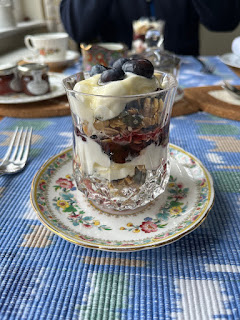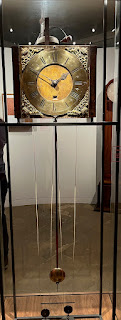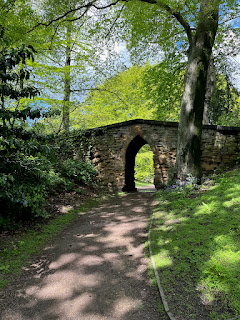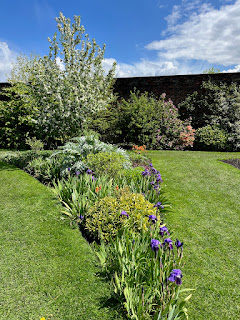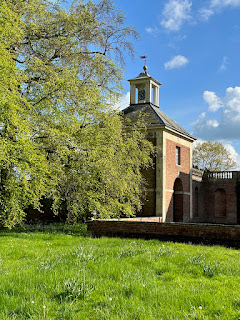This morning been drizzly, but breakfast was certainly not a disappointment. Here you can see the yogurt parfait that I enjoyed first thing!
It was perfection!
After we had our fill, we hopped in the car and headed towards York, to a country home known as Nostell House. Much to our delight, the sun popped out and the temperatures rose out of the 50's, actually into the low 70's! Now, that was a surprise!
It was quite obvious to us that many locals were taking advantage of the Coronation bank holiday weekend, as the property car lot was nearly full when we arrived at 11:00 AM! Luckily, the grounds are quite vast, so there was plenty of room for people to explore.

And here is the back view of the house.
To the side, stands what would have been the stables.
Nostell was built between 1727 and 1785, by two generations of the Winn family who had achieved wealth through London textile trade. They were considered to be members of the gentry class, having been knighted, and they wanted to improve their home to show off their status.
The famous architect, James Paine, was only 19 years old when he was commissioned by the 4th baronet Sir Rowland Winn to replace the house that already stood on this land. Unfortunately, the 4th baronet died before its completion, and the house was inherited by the 5th baronet. Also named Sir Rowland Winn, this man had fallen in love with a Swiss heiress named Sabine d'Hervart.
The family was against Sir Rowland marrying a "foreigner", but when the learned that she was wealthy, they accepted her into the family.
The newlyweds employed Robert Adam and Thomas Chippendale to make improvements to their newly inherited home. Sabine gave birth to the 6th baronet, heir to the house, in 1775.
Sabine's husband died young in a tragic carriage accident and she lost the enthusiasm for making improvements on the house. Rooms were left undecorated. Here you see a photo of what the Top Hall was originally designed to look like.

It wouldn't be until future generations until the room was completed. Here is what it looks like today.

The 6th baronet passed in 1817, and the estate passed down to Rowland and Sabine's grandson Charles Winn.
Charles did not have much interest in improving the house, but he was a buyer by hobby, and began to accumulate all kinds of unusual items in addition to a vast collection of books. He actually had so many books, that he created a second library, adjacent to the first, to hold them all. When his son, another named Rowland, inherited the house, the rooms were completed to stand as they do today.
The bedrooms were decorated with ornate furnishings:
and the house was filled with countless items made by Chippendale. Unlike those found in Paxton house these creations were much more ornate:
This is one of the mirrors made by Chippendale.
And this bureau is actually made by Chippendale but designed to have a Chinese look.
Amazing, don't you think?
I always find these servant bells to be fascinating. It's kind of like Downton Abbey revisited. We were told that each bell had a unique sound so that the staff would know by the ring who was in need of assistance.
Not only were the rooms ornate, but the stairs leading to the floors were unique creations of their own. Both of the sets of steps stand below an ornate ceiling surrounded by windows to let in the sunlight.
And some of the ceiling detail is truly exceptional.
One of the treasured items in the household collection is a clock made by John Harrison in 1717. It is constructed entirely of wood, and is one of the three of the remaining clocks in existence from this time period.
These are just a few examples of how this once neglected manor house was revised to its present state. It was gifted to the National Trust in 1954, and they continue to maintain it.
The house stands on an extremely large estate, and we chose to have a look around, strolling along the river walk. We felt quite fortunate that the sun had decided to visit today as well!
Bluebells were in bloom everywhere!
To the side of the house stand some fairly vast gardens which include not only flowers, but also fruit trees and just about any vegetable that one can grow in England. Here are some examples of the foliage.
Tulips were out of bloom, and the wildflowers were still yet to show their colors, but we still managed to view some of the beauty of these gardens.
At this point, we jumped in the car and headed back towards where we are staying, stopping at Beningbrough Hall.
I knew that the hall was still undergoing renovations, but had read that there were some unique gardens on the grounds, so we decided to take a look. I was immediately impressed with the lovely potted plant varieties as we entered the premises.
But first on the agenda: cream tea for two.
Don't judge. We did a LOT of walking today! After we were revitalized, we set out to explore the grounds.
There were some magnificent formal gardens to admire.
We strolled along to the back of the house (which, let's face it.....looks pretty impressive!)
and found ourselves in the old Victorian laundry, where the trust was having a used book store. Actually, that's not really so unusual. Nearly every National Trust place that we have visited has some sort of used books for sale.
But, I saw this very clever idea, and felt the need to share it.
Next to this sign, there were several piles of books, each wrapped in brown paper with a description on the outside.
I have some librarian friends whom I think will find that to be a really unique idea! You don't know what you get until you unwrap the paper!
The staff suggested that this was the perfect time to take the bluebell walk, and so we decided to give it a try. There are bluebells nestled under trees for most of the mile long walk.
This picture frame was set up in the perfect place to capture the house in the distance.
Lots of fun, for sure. And, speaking of fun....there's this as well:
After our "Sunday Roast" dinner at a nearby pub, we headed back to our B&B, where, once again, a treat awaited us in the sitting room.
Lemon drizzle cake.
I'm really going to miss this place!
Tomorrow we begin our westward journey to Wales. You know I'll keep you posted!




































